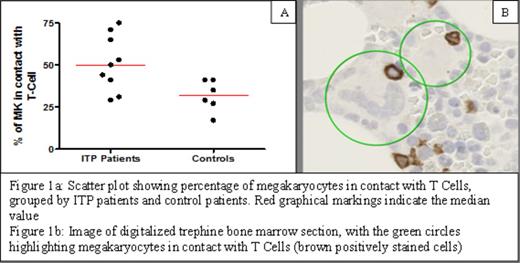Abstract
The pathology of immune thrombocytopenia (ITP) is not fully understood. Although antiplatelet antibodies (APAs) are thought to be causative, these are not detected in up to 30% of patients. In addition, T cell directed therapy is frequently successful. Patients with ITP display cytotoxic activity towards platelets, and abnormalities in T cell repertoire. However, there is incomplete understanding of the interactions between T cells and megakaryocytes within the bone marrow. We hypothesized that if T cell or NK cell cytotoxicity against megakaryocytes contributes to thrombocytopenia, then T and/or NK cells should be in direct contact with the megakaryocyte in the bone marrow. We therefore further explored the interactions between T cells and megakaryocytes in bone marrow trephine biopsies - taken at or near to diagnosis - in patients with ITP. To further explore apoptotic pathways, serum TRAIL levels were also assessed at different time points in disease.
Bone marrow trephine samples were taken as clinically indicated at or around the time of diagnosis and processed as per department protocol. Samples from patients with known ITP (n=9) were further processed and stained with CD3, CD8, CD4 and CD56. Immunohistochemistry was performed using Leica Bond-max automated immunohistochemistry system. The density of MK cells, CD3, CD8 and CD4 was recorded and the numbers of MK in contact with T or NK cells were recorded on multiple sites on the trephine. Control bone marrows from staging marrows for lymphoma were used for comparison (n=6). For further analysis of the non-antibody component of ITP, serum TRAIL levels were measured in 63 samples from 43 patients at different stages of disease. Patients had all consented for research.
Results of the bone marrow examination are shown in the table. Bone marrow samples from patients with ITP had higher density of megakaryocytes than control bone marrows (median 41/mm3 compared to 20/mm3 - p=0.03). Megakaryocytes appeared normal in morphology. CD3 density was also higher in patients with ITP, although this was not significant (p=0.17). There was however increased interaction between CD3 and MK cells in patients with ITP compared to controls (median 50% of MK cells in contact with CD3 cells in ITP compared to 32% in controls - p=0.02) – figure 1a. There was no correlation between MK cell density, T cell density and MK-T cell interaction, making this finding unlikely to have occurred by chance. In ITP patient samples further analysis of T cell type was undertaken and shown in the table showing interactions occur between both CD4s and CD8s and the MK cells (figure 1b). Four patients had reverse CD4:8 ratios in the bone marrow. Interaction between MK and CD56+ cells were less frequent (0 to 8%). There was no association with response to treatment and MK or T cell findings, although patients who responded to rituximab appeared to have lower MK density. Patients who responded to thrombopoietic (TPO) agonists - and by virtue of their use, had not responded to other treatments – had a high density of MK cells at diagnosis (bone marrows were taken at diagnosis, and before TPO agonists were started). Serum TRAIL levels were higher in patients with chronic ITP and with platelets <50 when compared to patients in remission (platelets > 150) (p<0.1). In patients with serial samples, there was an inverse relationship between TRAIL and platelet count.
| . | ITP Patients . | Controls . |
|---|---|---|
| MK Density (per mm2) | 41.2 [13.2 – 76.7] | 19.6 [10.8 – 33.3] |
| CD3 Density (per mm2) | 511.8 [297 – 805.9] | 317.5 [209 – 609] |
| T-Cell (CD3)/MK Cell Interaction (%) | 50 [29 – 75] | 32 [17 – 41] |
| CD4/MK Cell Interaction (%) | 52 [25 – 71] | N/A |
| CD8/MK Cell Interaction (%) | 25 [13 – 33] | N/A |
| NK Cell/MK Cell Interaction (%) | 6 [0 – 8] | N/A |
| . | ITP Patients . | Controls . |
|---|---|---|
| MK Density (per mm2) | 41.2 [13.2 – 76.7] | 19.6 [10.8 – 33.3] |
| CD3 Density (per mm2) | 511.8 [297 – 805.9] | 317.5 [209 – 609] |
| T-Cell (CD3)/MK Cell Interaction (%) | 50 [29 – 75] | 32 [17 – 41] |
| CD4/MK Cell Interaction (%) | 52 [25 – 71] | N/A |
| CD8/MK Cell Interaction (%) | 25 [13 – 33] | N/A |
| NK Cell/MK Cell Interaction (%) | 6 [0 – 8] | N/A |
Preliminary evidence suggests increased interactions between T cells and megakaryocytes in the bone marrow of patients with ITP. The demonstration of interactions between CD3 cells and MK cells in both patients and controls shows the importance of the MK cell in the immune system. Further investigation is under way to explore whether CD8 or NK cell interaction is only found in patients with ITP, and whether these interactions result in MK cell death, or reduction in platelet production. High TRAIL levels in patients with chronic disease, refractory to first and second line therapy further suggests that increased apoptosis plays an important role in the ongoing thrombocytopenia in chronic disease.
No relevant conflicts of interest to declare.
Author notes
Asterisk with author names denotes non-ASH members.


This feature is available to Subscribers Only
Sign In or Create an Account Close Modal